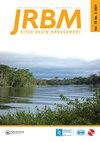具有相关水质影响的河岸侵蚀和稳定技术的高分辨率评估
IF 1.9
Q3 WATER RESOURCES
International Journal of River Basin Management
Pub Date : 2023-05-19
DOI:10.1080/15715124.2023.2214866
引用次数: 1
摘要
农业是造成水质差的主要原因,但农业集水区的沉积物和养分损失来源——包括河岸侵蚀——变化很大。河岸侵蚀尤其难以量化和控制。在这里,我们开发了一种快速评估方法,使用机载激光雷达结合现场收集的数据来量化河岸侵蚀率以及相关的沉积物和营养物质进入水道的速率。我们应用了这种方法,并在两个分析期内探讨了它与北爱尔兰黑水流域四个地点水质的关系。GIS激光雷达图像差异显示,河岸高程的体积变化等于平均侵蚀率,这表明侵蚀率的空间和时间变化。将侵蚀率与原位河岸堆积密度和总可提取磷含量相结合,提供了沉积物和磷负荷率。不同地点估计侵蚀量之间的相对差异与河流内悬浮泥沙的变化非常一致,但总磷浓度的模式更为复杂。我们得出的结论是,将激光雷达与现场数据相结合是河岸侵蚀量化的一种创新手段。此外,通过使用激光雷达到激光雷达的分析,可以确定河岸稳定技术后侵蚀、沉积物和磷负荷率的降低。本文章由计算机程序翻译,如有差异,请以英文原文为准。
High-resolution assessment of riverbank erosion and stabilisation techniques with associated water quality implications
Agriculture is a key contributor to poor water quality, but the sources of sediment and nutrient losses from agricultural catchments – including from riverbank erosion – are highly variable. Riverbank erosion is particularly difficult to quantify and control. Here, we developed a quick assessment approach to quantify riverbank erosion rates and associated sediment and nutrient loading rates into waterways using airborne LiDAR combined with field-collected data. We applied this approach and explored its relationships to water quality at four sites within the Blackwater catchment in Northern Ireland for two analysis periods. GIS LiDAR image differencing revealed that volume changes in riverbank elevation equated to average erosion rates which indicated spatial and temporal variability in erosion rates. Combining the erosion rates with in-situ riverbank bulk density and total extractable phosphorus content provided sediment and phosphorus loading rates. The relative differences between estimated erosion at the different sites corresponded well with in-stream suspended sediment variations, but patterns for total phosphorus concentrations were more complex. We conclude that the use of LiDAR combined with field data is an innovative means for riverbank erosion quantification. Furthermore, by using LiDAR-to-LiDAR analyses, the reductions in erosion, sediment, and phosphorus loading rates following riverbank stabilization techniques can be determined.
求助全文
通过发布文献求助,成功后即可免费获取论文全文。
去求助
来源期刊

International Journal of River Basin Management
WATER RESOURCES-
CiteScore
6.00
自引率
4.00%
发文量
48
期刊介绍:
include, but are not limited to new developments or applications in the following areas: AREAS OF INTEREST - integrated water resources management - watershed land use planning and management - spatial planning and management of floodplains - flood forecasting and flood risk management - drought forecasting and drought management - floodplain, river and estuarine restoration - climate change impact prediction and planning of remedial measures - management of mountain rivers - water quality management including non point source pollution - operation strategies for engineered river systems - maintenance strategies for river systems and for structures - project-affected-people and stakeholder participation - conservation of natural and cultural heritage
 求助内容:
求助内容: 应助结果提醒方式:
应助结果提醒方式:


